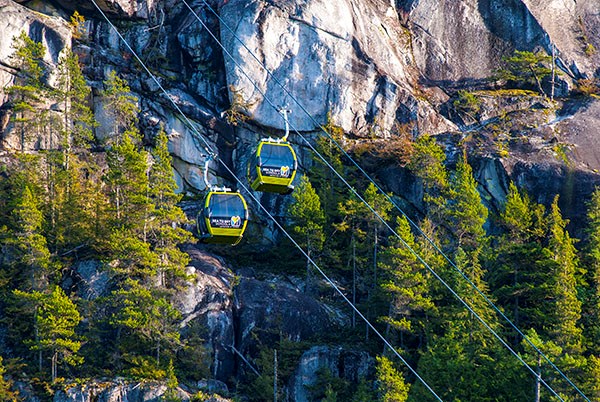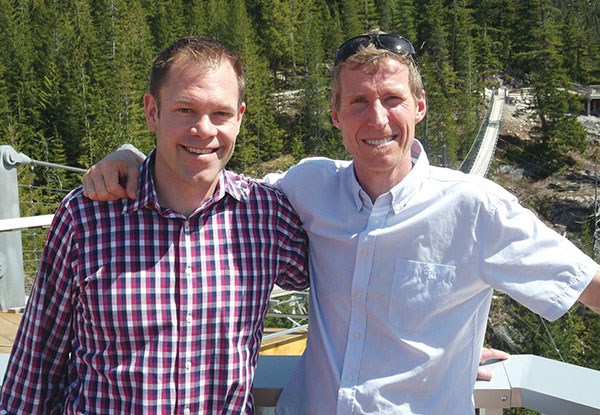Back in 2008-’09, when their company GroundEffects Developments Inc. was doing some consulting work on the Squamish Oceanfront project, Trevor Dunn and David Greenfield tossed around the idea of building the base area for what has become the Sea to Sky Gondola on the site of the former Nexen chemical plant west of the Mamquam Blind Channel.
The idea quickly evaporated into the Squamish mist, though.
“We thought it would be a great way to animate or activate the Oceanfront,” said David Greenfield, one of the so-called “three amigos” — Dunn and Michael Hutchison are the other two — who comprise the main partners in the $25 million cable tramway that opens to the public on Friday (May 16).
The Oceanfront base-area concept “just didn’t gain any momentum,” Greenfield said as the saws whirred and hammers pounded at the gondola’s top station as final preparations for the opening were being made.
“It would be of Peak to Peak Gondola proportions, which was just economically impossible. Then there were issues with it going over a federal waterway; there were float plane issues; and you were going over the power lines. It just really wasn’t feasible, but it was an interesting concept.”
For such a large project, though, the new concept of a gondola from a parcel of land near Highway 99 to a point below the ridge to Mount Habrich has certainly enjoyed great momentum since the day the idea went public in July 2011.
Dunn and Greenfield had worked together for many years with Intrawest Placemaking, playing a role in various resort developments in Mexico, the United States, Europe and even New Zealand, when they started kicking around ideas for a gondola in the years leading up to the 2010 Winter Olympics.
Together with Hutchison, a Sea to Sky-based developer with strong connections to local tradespeople, the three spent a couple of years looking up and down the corridor, scouting around for just the right location.
The three had no involvement in a 2004 proposal by Paul Mathews and Peter Alder to put a gondola to the summit of the Chief, a concept that didn’t fly primarily because it was inside a provincial park and because many hikers and climbers — not to mention First Nations — found the idea of putting a tramway up the Stawamus Chief preposterous.
Early on, the trio knew it had to have local First Nations on board, so even before going public with the idea in July 2011, they made presentations to both the Squamish and Tsleil-Waututh, both of whom claim the Squamish area as part of their traditional territories.
“We went to them as soon as we had the idea,” Hutchison said. “We approached them around the summer of 2010 and presented it to them. They wanted to know what we were doing — how, where and why.”
Bringing First Nations into the project from an early stage has a key for the project. Having the Squamish and Tsleil-Waututh share their rich culture will be of great value as part of the visitor experience, Dunn said.
“Captain [George] Vancouver promised a mutually beneficial economic partnership,” he said. “The First Nations are still kind of waiting for that to come, so we’ve involved them as economic partners from the early stages because we want them to share in the benefits.
“They’re part of the place, part of the history — you can’t separate them from a project like this. It’s been very positive and inspiring to have them involved.”
Before announcing their plans to the general public,the proponents presented the concept to literally dozens of local groups — from heritage groups to trails groups to the Chamber of Commerce. Those meetings were about both seeking input on the project’s details and building trust, Greenfield said.
It helped that the two had already spent a lot of time and built relationships in Squamish.
“In any big project, if you get that level of trust in the groups, they’re more likely to support you in the cause,” Greenfield said. “If you get developers from the outside, they don’t know you and they don’t know if you’re going to do something that might be successful but won’t involve or benefit them or the community. So there was a lot of work in engaging in and becoming ingrained in the community.
The successful completion of the project, Dunn said, “speaks to what can happen when the community gets behind something. It’s a really proud moment for Dave and I to be standing here, and talking about what helped get us here, that community support speaks volumes.”
Their biggest hurdle back then was convincing people that they really, honestly, had no interest in putting a gondola up the Chief.
During both the concept phase and after proponents they had settled on the location, the three did a lot of listening. In submitting the concept to various trails groups, it was suggested that their proposed top station — between Stawamus Chief and Shannon Falls provincial parks — was perhaps 750 metres too far north.
‘They said, ‘Keep it away from the Chief,’” Greenfield said. “They wanted to keep that as more of a pristine hiking experience, and we listened to them.”
Hutchison’s experience and connections in the development business have also been key to the project, Dunn said.

“A lot of pulling this project together was really Michael knowing exactly how to work in this community and work with the tradespeople he knows,” he said. “So the combination of the three skill sets really allowed us to move forward.”
Since well before announcing their plans to the public, the three have held fast to the belief that Squamish and vicinity offered unparalleled scenery, a unique and dynamic culture punctuated by an outdoors-oriented lifestyle and an almost captive stream of tourists running right by the facility’s doorstep.
“We’ve got all this traffic right at our doorstep — you don’t have to take someone with a sign saying, ‘It’s 10 kilometres this way,’” Greenfield said.
One of their goals has always been to offer tourism infrastructure that would not only be successful on its own, but would help build capacity for others in the industry.
“We’ve long had our eyes in what could work,” Greenfield said. “The tourism side of Squamish just seemed to us to be underexploited. You’ve got the Chief and Shannon Falls, and a culture here that’s built around recreation, but we just felt the mainstream side of tourism here seemed to be underserved.”
Some have been critical of the project because it appears mostly geared toward mainstream tourists who — unlike many who have enjoyed visiting Squamish until now — may not have the fitness or inclination to get up into the alpine on their own and explore.
Dunn, though, is unapologetic. Noting that the gondola cabins and even some of the trails around the top station are completely wheelchair accessible, he said both mainstream tourists and those wishing to use the gondola to access more strenuous activities are among the customers the gondola aims to attract.
“Our tagline is, ‘Adventure by nature,’” he said. “Whether your adventure is a walk on our accessible trails or climbing [nearby mountain] Sky Pilot, all of those people are welcome to have that adventure and come back to the lodge and celebrate it here.”
He also offered a thought for the hundreds of local residents who came out to those dozens of community meetings and provided their input.
“When people see what we’ve done, I think we can say we did what we said we were going to do,” Dunn said, “and when people come up here and see for themselves, I think they’ll be impressed and say we’ve been true to our word.”




